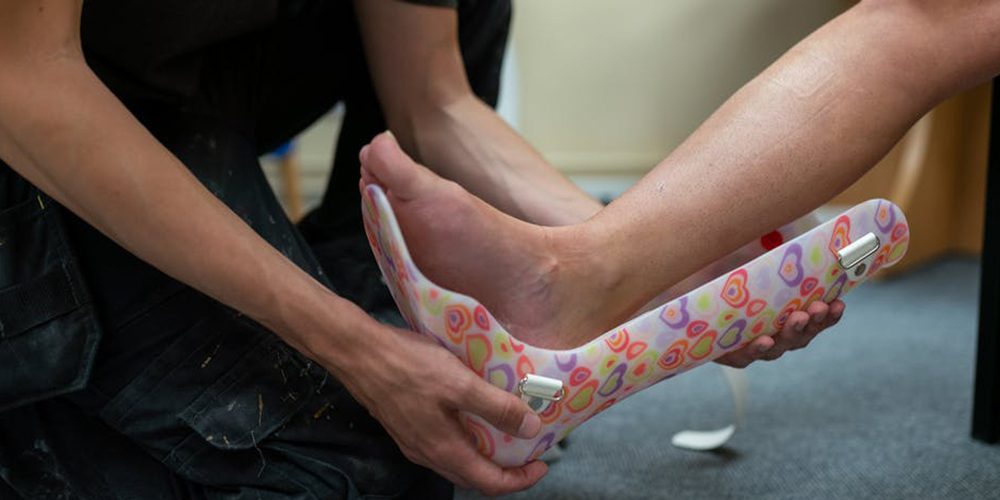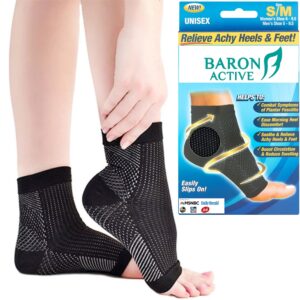A broken foot is an injury where one (or more) bones in your feet break. You may experience a break during an event like a car crash or from a simple misstep or fall. There are many different types of fractures that can range from tiny cracks in your bones to breaks that pierce your skin. The seriousness of the fracture will determine the treatment, but if it’s severely broken, surgery may be required to implant plates, rods or screws into the broken bone to maintain proper position during healing.
This article is part of our “foot pain” series. If you want to learn more about all kinds of foot pain, conditions and problems, please feel free to check out all of the other articles on our blog.
Symptoms
Symptoms of a broken foot may include grinding or snapping sounds, swelling and bruising, pain when walking or moving your toes, loss of movement in the joint at the site of the break and pain that increases with activity. It is typically recommended to seek medical attention if you have any symptoms associated with a broken foot.
If there is an obvious deformity of your foot and if the swelling and pain doesn’t get better with self-care and treatment, you should see a doctor immediately. If the injury makes it impossible to walk, you shouldn’t waste any time and head directly to the ER.
Causes of a broken foot
A broken foot can occur in a number of ways, including:
-Falling from a significant height or onto your feet
-Sports injuries
-Car accidents where you are thrown violently forward or backward against an object or the ground
-Slipping and falling (on stairs or ice)
-Horseback riding accidents
-Walking on a broken surface
-Dropping something heavy on your foot
What activities and risk factors favor a broken foot?
Though a broken foot can have many different causes, statistically you’re at a higher risk if you:
- Participate in sports that involve your feet. Sports such as football, basketball, tennis, gymnastics or soccer cause a lot foot fractures each year.
- Are over the age of 60. Fractures in seniors are more likely to be serious and these people can also have additional health problems that make broken bones harder to heal
- Participate in high-risk activities such as mountain biking or skiing. These sports require you to stand on your feet for long periods of time and what might appear like a
- Work in dangerous environments. Construction workers, for example, have a higher risk of dropping something heave on their foot or falling from a height
- Have health conditions. Osteoporosis puts you at tis of injuries to your bones
- Use the wrong technique or equipment. Wearing the wrong shoes that don’t fit properly or not warming up before sports can cause foot injuries, of course
Diagnosis
Your doctor may be able to diagnose your broken foot through a physical examination alone. They will look for discoloration, swelling and deformities of the area.
If there is any doubt about where you might have injured yourself, an X-ray can be used to determine if there are fractures present. Sometimes it takes more sophisticated imaging tools like a computerized tomography scan (CT) or magnetic resonance imaging (MRI) to figure out the exact location of your break.
Treatment & Therapy
The severity of your fracture will determine the best treatment plan. Minor fractures can be treated with a cast and crutches, but if your foot is severely broken, surgery may be required to implant plates, rods or screws into the broken bone to maintain proper position during healing.
Most fractures heal within six weeks, but they may take as long as three months depending on the severity of your injury and other health conditions like diabetic neuropathy or osteoporosis that could affect the recovery time.
To help you speed up the healing process:
-Try to keep your foot elevated as much as possible.
-Ice you foot regularly, every three to four hours for 20 minutes at a time. This can help decrease pain and inflammation.
-Take over-the counter medications to ease the pain.
-Ask your doctor about exercises that can strengthen the muscles in your foot.
-Eat a well-balanced diet. You heal faster when you are getting all of the nutrients you need.
-Take as much weight off the broken foot as possible. If you can’t bear any weight on the foot, ask someone to help you by getting things at eye level or lower.
-Balance yourself around your home with furniture or grab bars (in the shower). Once your foot heals enough for you to be able to put some pressure on it, these activities will make it easier for you to get around.
-Wear a case, splint, brace, boot or special shoes to protect the area.
After your bones has healed, you will most likely need to strengthen your muscles and loosen up stiff joints and ligaments in your feet. A physical therapist can help you with this process.
Surgery
In some cases, a broken bone might be so severely injured that it can’t heal on its own. In addition to being embedded into muscles and tissue, the fracture may have also damaged your blood vessels, tendons or ligaments.
Plates, rods and screws may be used to increase stability during healing or help you avoid further injury or deformity. Other treatments that you doctor may recommend for severely broken feet include:
- Mobilization of the foot and ankle: Your doctor will realign the bones, tendons and ligaments to restore function in your foot. They might manipulate your joints manually or use electrical stimulation or heat treatment to relax muscles.
- Arthroscopy: If your ligaments or cartilage are damaged, it may be necessary to clean out the area with an arthroscope.
- Arthrodesis: Several surgeries may be required to remove torn pieces of bone and fuse together healthy bones in the injured site. This procedure stabilizes joints so that they can’t move or cause pain anymore.
Prevention
The best way to prevent broken feet is to stay active and warm up before you play sports or exercise. Wear the right shoes that fit properly.
When your shoes wear out, replace them regularly. This is especially important for runners, so you should have a close look at your running shoes every now and then.
Always start slow if you start a new sports or exec program. If the activity is unfamiliar, your muscles may not be strong enough to support you.
Whenever you are on your feet for extended periods of time, wear comfortable shoes that fit well and cushion your feet. If you have an old injury or a chronic condition like diabetes, peripheral vascular disease or rheumatoid arthritis, talk to your doctor about exercises or stretches that can help strengthen your muscles.
In case you have had surgery, it may be important for you to get medical clearance before getting back into an active life.
Conclusion
Broken foot symptoms, treatments and healing time can range from a small crack to a severe fracture. The most common treatment for a broken foot is weight bearing immobilization through casts or surgical fixation with plates, rods and screws. In some cases surgery may be necessary to repair the damage done by the break in your bones; this might involve removing torn pieces of bone, realigning joints with muscle relaxation exercises or fusing together fractured bones. It’s important that you engage in physical therapy after breaking your foot as it will help strengthen muscles and loosen up stiff joints and ligaments quicker than they would heal on their own. If you have had any experience dealing with these injuries please share them below! We would love to hear about how we can make our blog post even more helpful. Your input is always appreciated!






















